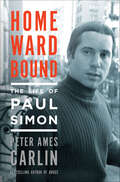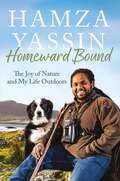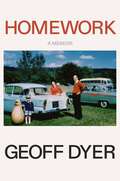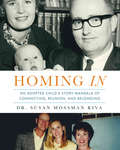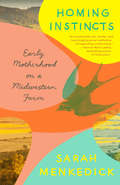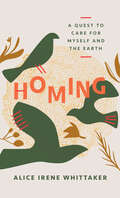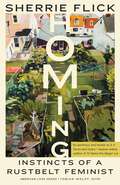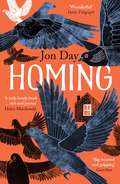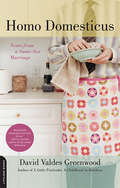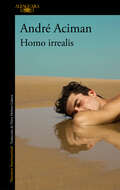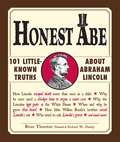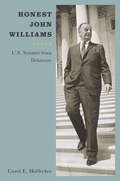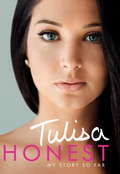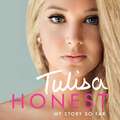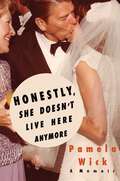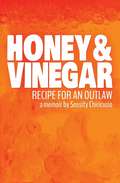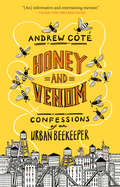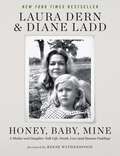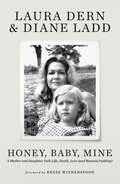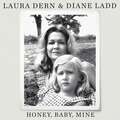- Table View
- List View
Homeward Bound: The Life of Paul Simon
by Peter Ames CarlinA revelatory account of the life of beloved American music icon, Paul Simon, by the bestselling rock biographer Peter Ames CarlinTo have been alive during the last sixty years is to have lived with the music of Paul Simon. The boy from Queens scored his first hit record in 1957, just months after Elvis Presley ignited the rock era. As the songwriting half of Simon & Garfunkel, his work helped define the youth movement of the '60s. On his own in the '70s, Simon made radio-dominating hits. He kicked off the '80s by reuniting with Garfunkel to perform for half a million New Yorkers in Central Park. Five years later, Simon’s album “Graceland” sold millions and spurred an international political controversy. And it doesn’t stop there. The grandchild of Jewish emigrants from Galicia in the Austro-Hungarian empire, the 75-year-old singer-songwriter has not only sold more than 100 million records, won 15 Grammy awards and been installed into the Rock ‘n’ Roll Hall of Fame twice, but has also animated the meaning—and flexibility—of personal and cultural identity in a rapidly shrinking world. Simon has also lived one of the most vibrant lives of modern times; a story replete with tales of Carrie Fisher, Leonard Bernstein, Bob Dylan, Woody Allen, Shelley Duvall, Nelson Mandela, drugs, depression, marriage, divorce, and more. A life story with the scope and power of an epic novel, Carlin’s Homeward Bound is the first major biography of one of the most influential popular artists in American history.
Homeward Bound: The joy of nature and my life outdoors
by Hamza Yassin'He is delight and joy personified' - MARIAN KEYES'Set to become BBC's next David Attenborough' - DAILY MAIL'Brings a little bit of joy to us all' - GUARDIANHamza has always loved the outdoors.Hamza Yassin loves being outdoors in nature. As a child who struggled with dyslexia at school, he always longed to be in the world outside the classroom. Thankfully, due to a forward-thinking teacher who encouraged him to run outside before a lesson, Hamza embraced his love of nature from an early age. There he discovered that his dyslexia allowed him to see the world in a special way.Homeward Bound tells the story of Hamza's fascination with the outdoors. From learning to ring birds in Wales to chasing orca in Scotland - Hamza explores wildlife across the British Isles and delights in the hidden life that is found there. Throughout his journey, he shows us the wonder of wildlife and how mother nature is a home for us all. Packed with charming personal stories, including life in the Scottish Highlands, and his adventures as a wildlife cameraman - Hamza shares the joy of nature and shows us how it has made him who he is today.
Homeward Bound: The joy of nature and my life outdoors
by Hamza Yassin'He is delight and joy personified' - MARIAN KEYES'Set to become BBC's next David Attenborough' - DAILY MAIL'Brings a little bit of joy to us all' - GUARDIANHamza has always loved the outdoors.Hamza Yassin loves being outdoors in nature. As a child who struggled with dyslexia at school, he always longed to be in the world outside the classroom. Thankfully, due to a forward-thinking teacher who encouraged him to run outside before a lesson, Hamza embraced his love of nature from an early age. There he discovered that his dyslexia allowed him to see the world in a special way.Homeward Bound tells the story of Hamza's fascination with the outdoors. From learning to ring birds in Wales to chasing orca in Scotland - Hamza explores wildlife across the British Isles and delights in the hidden life that is found there. Throughout his journey, he shows us the wonder of wildlife and how mother nature is a home for us all. Packed with charming personal stories, including life in the Scottish Highlands, and his adventures as a wildlife cameraman - Hamza shares the joy of nature and shows us how it has made him who he is today.
Homeward Bound: The joy of nature and my life outdoors
by Hamza Yassin'He is delight and joy personified' - MARIAN KEYES'Set to become BBC's next David Attenborough' - DAILY MAIL'Brings a little bit of joy to us all' - GUARDIANHamza has always loved the outdoors.Hamza Yassin loves being outdoors in nature. As a child who struggled with dyslexia at school, he always longed to be in the world outside the classroom. Thankfully, due to a forward-thinking teacher who encouraged him to run outside before a lesson, Hamza embraced his love of nature from an early age. There he discovered that his dyslexia allowed him to see the world in a special way.Homeward Bound tells the story of Hamza's fascination with the outdoors. From learning to ring birds in Wales to chasing orca in Scotland - Hamza explores wildlife across the British Isles and delights in the hidden life that is found there. Throughout his journey, he shows us the wonder of wildlife and how mother nature is a home for us all. Packed with charming personal stories, including life in the Scottish Highlands, and his adventures as a wildlife cameraman - Hamza shares the joy of nature and shows us how it has made him who he is today.
Homework: A Memoir
by Geoff DyerNamed a most anticipated book of 2025 by Vulture | The Guardian | Financial Times | The Observer | The Times (London) | Literary Hub"A picture of postwar England unlike any other . . . A highly original memoir that will provoke, amuse, beguile—and endure." —Antony Quinn, Financial Times"Homework is wonderful Geoff-Dyer writing, which we've all learned to crave; something to delight and to move us and to edify us on every page. I find him an irresistible writer." —Richard FordA portrait of a young boy, who keeps passing exams—and of a changing England in the 1960s and 1970s.The only child of a sheet-metal worker and a dinner lady who worked at the canteen of the local school, Geoff Dyer grew up in a world shaped by memories of the Depression and the Second World War. But far from being a story of hardship overcome, this loving memoir is a celebration of opportunities afforded by the postwar settlement, of which the author was an unconscious beneficiary. The crux comes at the age of eleven with the exam that decided the future of generations of British schoolkids: secondary modern or the transformative possibilities of grammar school? One of the lucky winners, Dyer goes to grammar school, where he develops a love of literature (and beer and prog rock).Mapping a path from primary school through the tribulations of teenage sport, gig-going, romantic fumblings, fights (well, getting punched in the face), and other misadventures with comic affection, Homework takes us to the threshold of university, where Dyer gets the first intimations that a short geographical journey—just forty miles—might extend to the length of a life.Recalling an eroded but strangely resilient England, Homework traces, in perfectly phrased and hilarious detail, roots that extend into the deep foundations of class society.
Homing In: An Adopted Child's Story Mandala Of Connecting, Reunion, And Belonging
by Dr Susan Mossman RivaHoming Instincts: Early Motherhood on a Midwestern Farm
by Sarah MenkedickSarah Menkedick spent her twenties trekking alone across South America, teaching English to recalcitrant teenagers on Reunion Island, picking grapes in France and camping on the Mongolian grasslands; for her, meaning and purpose were to be found on the road, in flight from the ordinary. Yet the biggest and most transformative adventure of her life might be one she never anticipated: at 31, she moves into a tiny 19th-century cabin on her family's Ohio farm, and begins the journey into motherhood. In eight vivid and boldly questioning essays, Menkedick explores the luminous, disorienting time just before and after becoming a mother. As she reacquaints herself with the subtle landscapes of the Midwest, and adjusts to the often surprising physicality of pregnancy, she ruminates on what this new stage of life means for her long-held concepts of self, settling, and creative fulfillment. In “Millie, Mildred, Grandma Menkedick,” she considers the nature of story through the life of her tough German grandmother, who raised two boys as a single mother in the 1950s and then spent her seventies traveling the world with her best friend Marge; in “Motherland,” on a trip back to Oaxaca, Mexico to visit her husband’s family, she finally embraces her Midwestern roots; in “The Milk Cave,” she discovers in breastfeeding a new appreciation for the spiritual and artistic potential of boredom; and in “The Lake,” she revisits her childhood with her father, whose relentless optimism and mystical streak she sees anew once she has a child of her own. A story of a traveler come home to the farm; of becoming a mother in spite of reservations and doubt; and of learning to appreciate the power and beauty of the quotidian, Homing Instincts speaks to the deepest concerns and hopes of a generation.
Homing: A Quest to Care for Myself and the Earth
by Alice Irene WhittakerA memoir about abandoning an exhausting commuter lifestyle to move to a cabin in the woods, embracing imperfection while cultivating a life of care for self and nature.Alice Irene Whittaker was addicted to productivity, perfectionism, and discipline, making sure that every single moment of the day was accounted for. Then she finds herself as a new mother, commuting four hours a day into the city, exhausted by the state of the world, paralyzed by climate guilt and anxiety. Overnight, Alice Irene and her family decide to retreat to a cabin in the woods, in search of a new kind of life. Surrounded by creek, meadow, and forest, Alice Irene begins a new lifelong journey of repairing her fractured relationship with both herself and the natural world. Her quest takes her to meet a renowned economist-rancher in Colorado, to stand at the side of a runway at a sustainable fashion show in Portland, and to witness firsthand rewilding of wolves in Yellowstone. She interviews and learns from dozens of people who are building homes, growing food, making clothes, raising families, and living their lives in regenerative ways. Searching for the spaces between the sorrow of wildfires and the beauty of wildflowers, Homing is a lyrical memoir about moving from a life of despair to a life of care.
Homing: Instincts of a Rustbelt Feminist (American Lives)
by Sherrie FlickHoming: Instincts of a Rustbelt Feminist traces the creative coming of age of a mill-town feminist. Sherrie Flick, whose childhood spanned the 1970s rise and 1980s collapse of the steel industry, returned to Pittsburgh in the late 1990s, witnessing the region&’s before and its after. With essays braiding, unbraiding, and then tangling the story of the author&’s father with Andy Warhol, faith, dialect, labor, whiskey, Pittsburgh&’s South Side Slopes neighborhood, grief, gardening, the author&’s compulsion to travel, and her reluctance to return home, Flick examines how place shaped her experiences of sexism and feminism. She also looks at the changing food and art cultures and the unique geography that has historically kept this weird hilly place isolated from trendy change. Carefully researched, deeply personal, and politically grounded in place and identity, Homing is an explicitly feminist and anti-nostalgic intervention in writing about the Rustbelt.
Homing: On Pigeons, Dwellings and Why We Return
by Jon DayA SPECTATOR BOOK OF THE YEARLonglisted for the William Hill Sports Book of the Year'Rich and joyous ...The book's quiet optimism about our ability to change, and to learn to love small things passionately, will stay with me for a long time' Helen Macdonald'Big-hearted and quietly gripping' Guardian'I love Jon Day's writing and his birds. A marvellous, soaring account' Olivia Laing'[A] beautiful book about unbeautiful birds' Observer'This is nature writing at its best' Financial Times'Awash with historical and literary detail, and moving moments ... Wonderful' Telegraph'Every page of this beautifully written book brought me pleasure' Charlotte Higgins'A vivid evocation of a remarkable species and a rich working-class tradition. It's also a charming defence of a much-maligned bird, which will make any reader look at our cooing, waddling, junk-food-loving feathered friends very differently in future' Daily Mail'Endlessly interesting and dazzlingly erudite, this wonderful book will make a home for itself in your heart' ProspectAs a boy, Jon Day was fascinated by pigeons, which he used to rescue from the streets of London. Twenty years later he moved away from the city centre to the suburbs to start a family. But in moving house, he began to lose a sense of what it meant to feel at home.Returning to his childhood obsession with the birds, he built a coop in his garden and joined a local pigeon racing club. Over the next few years, as he made a home with his young family in Leyton, he learned to train and race his pigeons, hoping that they might teach him to feel homed.Having lived closely with humans for tens of thousands of years, pigeons have become powerful symbols of peace and domesticity. But they are also much-maligned, and nowadays most people think of these birds, if they do so at all, as vermin.A book about the overlooked beauty of this species, and about what it means to dwell, Homing delves into the curious world of pigeon fancying, explores the scientific mysteries of animal homing, and traces the cultural, political and philosophical meanings of home. It is a book about the making of home and making for home: a book about why we return.
Homing: On Pigeons, Dwellings and Why We Return
by Jon DayA SPECTATOR BOOK OF THE YEARLonglisted for the William Hill Sports Book of the Year'Rich and joyous ...The book's quiet optimism about our ability to change, and to learn to love small things passionately, will stay with me for a long time' Helen Macdonald'Big-hearted and quietly gripping' Guardian'I love Jon Day's writing and his birds. A marvellous, soaring account' Olivia Laing'[A] beautiful book about unbeautiful birds' Observer'This is nature writing at its best' Financial Times'Awash with historical and literary detail, and moving moments ... Wonderful'Telegraph'Every page of this beautifully written book brought me pleasure' Charlotte Higgins'A vivid evocation of a remarkable species and a rich working-class tradition. It's also a charming defence of a much-maligned bird, which will make any reader look at our cooing, waddling, junk-food-loving feathered friends very differently in future' Daily Mail'Endlessly interesting and dazzlingly erudite, this wonderful book will make a home for itself in your heart' ProspectAs a boy, Jon Day was fascinated by pigeons, which he used to rescue from the streets of London. Twenty years later he moved away from the city centre to the suburbs to start a family. But in moving house, he began to lose a sense of what it meant to feel at home.Returning to his childhood obsession with the birds, he built a coop in his garden and joined a local pigeon racing club. Over the next few years, as he made a home with his young family in Leyton, he learned to train and race his pigeons, hoping that they might teach him to feel homed.Having lived closely with humans for tens of thousands of years, pigeons have become powerful symbols of peace and domesticity. But they are also much-maligned, and nowadays most people think of these birds, if they do so at all, as vermin.A book about the overlooked beauty of this species, and about what it means to dwell, Homing delves into the curious world of pigeon fancying, explores the scientific mysteries of animal homing, and traces the cultural, political and philosophical meanings of home. It is a book about the making of home and making for home: a book about why we return.
Homo Domesticus: Notes from a Same-Sex Marriage
by David Valdes GreenwoodA whimsical valentine to true love--and a testament to the very ordinary lives of an extraordinary couple
Homo Irrealis
by André AcimanEL NUEVO LIBRO DEL AUTOR DE LLÁMAME POR TU NOMBRE Y LEJOS DE EGIPTO, GANADOR DEL WHITING AWARD Y EL LAMBDA LITERARY AWARD, TRADUCIDO A 38 IDIOMAS Y ACLAMADO POR LA CRÍTICA Y LOS LECTORES ¿Cuánto de nosotros se borra con el paso del tiempo? ¿Cuánto se queda en los lugares amados? ¿Puede uno regresar a un lugar que nunca existió más allá de su mente? En Homo irrealis, André Aciman nos invita a acompañarlo al territorio de sus recuerdos en un viaje por lugares queridos como Alejandría, Roma, París, San Petersburgo o Nueva York, habitados por las presencias fantasmales de artistas y escritores amados. De la mano de Proust, Freud, Cavafis, Pessoa, Rohmer, Sebald y muchos más, el autor explora el tiempo irrealis: el del hombre que podría haber sido y no fue, todo lo que podría haber pasado y no pasó, pero que aún podría pasar y está en un limbo entre la fantasía y la realidad. Unasmemorias en forma de ensayos en las que el autor de Lejos de Egipto y de Llámame por tu nombre revisita el pasado y el presente, el anhelo y el deseo, en un intento de comprender la veta nostálgica que se cierne sobre su persona y sobre casi toda su obra. La crítica ha dicho:«Si Proust no hubiera existido, el señor Aciman lo habría inventado».Richard Bernstein, The New York Times «Recuerda a los escritos de W. G. Sebald y de Fernando Pessoa, y transmite con gracia y perspicacia su anhelo de capturar el yomirando al yo que es en ese momento. Un libro brillante de un escritor que nunca decepciona».Kirkus Reviews «Uno de los mejores ensayistas de los últimos cien años».Susan Salter Reynolds, Los Angeles Review of Books «Una exploración de lo irreal diabólicamente compleja y reveladora. Los ensayos que discuten lo irreal en la obra de sus artistas más admirados, como el tríptico de ensayos sobre el cineasta Eric Rohmer, que casi se pueden leer como cartas de amor, hacen que este libro se eleve a nuevas alturas».The Irish Times «Un lento paseo por capitales fascinantes, un tierno recuerdo de viejas y raras películas, una fresca contemplación de los gigantes literarios modernistas: así podríamos describir el material de la nueva colección de ensayos de André Aciman, pero no su magia. [...] Este libro encarna, de manera inteligente y conmovedora, a su creador en toda su realidad».The Boston Globe«Estos ensayos me devolvieron a la vida, como hace la buena literatura».Sukada Tatke, The Rumpus «Una nueva colección de ensayos brillante y cautivadora [...]: felicidad pura».David Mikics, Tablet «Leer a André Aciman es como enamorarse».Xavi Ayén, La Vanguardia«Un maestro de la sensualidad y los detalles exquisitos».Sagrario Fernández-Prieto, La Razón
Homosexuals in History: A Study of Ambivalence in Society, Literature and the Arts
by A. L. RowseRichard Coeur-de-Lion, Johann Joachim, Fritz Krupp, Erasmus, Winckelmann, Leonardo da Vinci, Lord Byron, Ernst Röhm, Michelangelo, Tchaikovsky, E. M. Forster, Christopher Marlowe, Diaghilev, Somerset Maugham, Henri III, Oscar Wilde, Noel Coward, Francis Bacon, Rimbaud and Verlaine, T. E. Lawrence, James I, Walt Whitman, Louis XIII, Marcel Proust, Herman Melville, Horace Walpole, André Gide, Nathaniel Hawthorne, Frederick the Great, Jean Cocteau, Henry James, Jean Genet and numerous others walked every path of life and left their marks, sometimes for good, sometimes for evil, in every field of endeavor. Their single similarity was the sexual preference they shared--and the stigma society placed upon it. Now eminent English historian A. L. Rowse examines homosexual men of genius throughout history and the _ courageous, often desperate responses they made to society's hypocrisy.
Honest Abe: 101 Little-Known Truths about Abraham Lincoln
by Brian ThorntonOne hundred fifty years after his death, Abraham Lincoln remains one of America's most fascinating, brilliant, and visionary leaders. He's idolized as a hero, a legend, and even a secular saint. In this engaging, intelligent book, you will learn about more than just his savvy political skills and Civil War power plays, including: How Lincoln escaped death more than once as a childWhy the Lincolns kept goats at the White HouseHow John Wilkes Booth's brother saved Lincoln's sonWho tried to rob Lincoln's graveHonest Abe--because what you didn't know will surprise you!
Honest John Williams: U.S. Senator from Delaware (Cultural Studies of Delaware and the Eastern Shore)
by Carol E. HoffeckerJohn J. Williams was elected to the U.S. Senate in 1946, defeating incumbent Democratic U.S. Senator James M. Tunnell. Honest John Williams: U.S. Senator from Delaware examines the political career of Williams, a political novice who established himself as an important advocate for fiscal probity and integrity in government during four successive terms in the U.S. Senate between 1947 and 1970. Over the course of those twenty-four years in the Senate, which spanned the administrations of five separate U.S. presidents (Truman, Eisenhower, Kennedy, Johnson, and Nixon), Williams positioned himself as an opponent of wasteful government spending and corruption, often working "across the aisle" in order to achieve specific political goals. In Honest John Williams, noted Delaware historian Carol E. Hoffecker offers readers a comprehensive look at the legislative course forged by Delaware’s first four-term senator, a chicken-feed dealer born on a farm near Sussex County who went on to become an important advocate for fiscal probity and integrity in twentieth-century American politics.
Honest: The Official Autobiography
by Tulisa ContostavlosTulisa Contostavlos is one of the most talented and high-profile recording artists working in the UK today. She has three platinum N-Dubz albums, four MOBO awards, a groundbreaking drama series, two documentaries, a MIND award and an X Factor judge's win under her belt. Not bad for a girl who's not yet twenty-four. But this is not just a tale of glittering success. Tulisa grew up on a tough London estate and left school with no qualifications as she struggled to cope with deep-seated emotional problems while caring for her mother alone. She has seen first hand what drugs, alcohol, gang culture and violent relationships can do to young people, but she has come through it all to become the confident, inspiring artist she is today. After taking her little muffins Little Mix to the winning spot of the X Factor at the end of 2011, and with her long-awaited solo album being released later this year, the future is bright for Tulisa. Told in her own words, this is her story.
Honest: The Official Autobiography
by Tulisa ContostavlosTulisa Contostavlos is one of the most talented and high-profile recording artists working in the UK today. She has three platinum N-Dubz albums, four MOBO awards, a groundbreaking drama series, two documentaries, a MIND award and an X Factor judge's win under her belt. Not bad for a girl who's not yet twenty-four. But this is not just a tale of glittering success. Tulisa grew up on a tough London estate and left school with no qualifications as she struggled to cope with deep-seated emotional problems while caring for her mother alone. She has seen first hand what drugs, alcohol, gang culture and violent relationships can do to young people, but she has come through it all to become the confident, inspiring artist she is today. After taking her little muffins Little Mix to the winning spot of the X Factor at the end of 2011, and with her long-awaited solo album being released later this year, the future is bright for Tulisa. Told in her own words, this is her story.
Honest: The Official Autobiography
by Tulisa ContostavlosTulisa Contostavlos is one of the most talented and high-profile recording artists working in the UK today. She has three platinum N-Dubz albums, four MOBO awards, a groundbreaking drama series, two documentaries, a MIND award and an X Factor judge's win under her belt. Not bad for a girl who's not yet twenty-five.But this is not just a tale of glittering success. Tulisa grew up on a tough London estate and left school with no qualifications as she struggled to cope with deep-seated emotional problems while caring for her mother alone. She has seen first hand what drugs, alcohol, gang culture and violent relationships can do to young people, but she has come through it all to become the confident, inspiring artist she is today. After taking her little muffins Little Mix to the winning spot of the X Factor at the end of 2011, and with her long-awaited solo album being released later this year, the future is bright for Tulisa. Told in her own words, this is her story.(P)2012 Headline Digital
Honestly, She Doesn't Live Here Anymore
by Pamela WickIn the charged political landscape of Reagan-era Washington, a young woman finds herself grappling with her father&’s high-profile scandal and her own impending divorce, forcing her to confront her privileged childhood and navigate the notoriety of a personal friendship with the first family.I think about my glamorous wedding again. I imagine myself choking on a cheese ball, in my lace wedding gown, guests rushing over arguing about who does the best Heimlich maneuver, my face bright red from lack of oxygen. Then, as if that weren&’t bad enough, I pass out on the dance floor of the tented tennis court where our lavish reception was held. My father, in his tux, at the mic, in front of the Les Brown Orchestra, telling everyone the marriage won&’t last and he might go to prison. The shattered fairy tale is on a loop inside my head. How did my life reverse itself so drastically? For Pamela Wick, President and Mrs. Reagan were simply Ronnie and Nancy, her parents&’ best friends. What began with Pamela&’s mom and Nancy organizing the chili booth at their kids&’ school fair in Los Angeles soon propelled Pamela&’s parents into pivotal roles that would help Reagan secure the California governorship and eventually the grand prize: the White House. Determined to win her parents&’ approval as the perfect daughter, Pamela marries the son of Republican royalty and joins them in DC to begin her fairytale in the nation&’s Capitol—or so she thought. What follows is her firsthand look behind the scenes at the gilded age of the Reagan years in Washington, DC—an era now long gone. Sometimes hilarious, sometimes heartbreaking, but always insightful, the narrative chronicles her journey to penetrate Washington society at the highest levels—from Christmas Eve at her family home with President Reagan dressed as Santa Claus, to intimate dinners at the White House. But behind the golden gates, Pam&’s marriage is unraveling, and her father&’s high-profile political scandal threatens to destroy their carefully constructed life. Soon, she&’s trading in glitzy state dinners for congressional hearings attacking her father, and at the center of the Reagan revolution, Pam&’s own personal uprising begins.
Honey & Vinegar: Recipe for an Outlaw
by Sossity ChiricuzioHoney & Vinegar: Recipe for an Outlaw gives an intimate look at how the values and hopes of the 1960s carried through into the queer activism of the 1990s. It's a story told from various locations including ashrams, community housing, and not so great neighborhoods from the middle of Arizona to the middle of Florida, and back again. Exploring issues of class, family, embodiment, sexuality, identity, and agency in an illustrated series of vignettes that blur the lines between poetry and prose, Honey & Vinegar is a scrapbook of resistance.
Honey and Venom: Confessions of an Urban Beekeeper
by Andrew CotéA year in the life of New York City&’s premier beekeeper, who chronicles his adventures and the quirky personalities he encounters while spreading his infinite knowledge of and passion for the remarkable honey bee. &“Coté&’s charming and poignant essay collection delivers the entertainment and smarts required to make real change in how we look at our planet—and ourselves.&”—Andrew ZimmernConsidered an &“industry legend&” by The New York Times, Andrew Coté has one of the most intriguing, challenging, and unique jobs in New York City—maintaining millions of honey bees atop some of the city&’s most iconic buildings. His apiaries have crowned the Waldorf Astoria and the Museum of Modern Art; reside on the North Lawn of the United Nations; reign above stores, hotels, restaurants, schools, churches, and synagogues; and are situated in community gardens, and even cemeteries, throughout the five boroughs. In this debut collection, Coté takes readers with him on his daily apiary adventures over the course of a year, in the city and across the globe. Here, among his many duties, he is called to capture swarms that have clustered on fire hydrants, air-conditioning units, or street-vendor umbrellas. Annually, he travels with his father to regions like remote Fijian islands, rural Uganda, Haiti, Ecuador, or Iraq with his organization, Bees Without Borders, where he teaches beekeepers how to increase their honey yield and income via beekeeping endeavors. Written with Coté&’s trademark humor, acumen, and a healthy dose of charm, Honey and Venom illuminates the obscure culture of New York City &“beeks&” and the biology of the bees themselves, from the humble drone to the fittingly named worker to the queen herself—who is more a slave than a monarch. The hive world, Coté reveals, is full of strivers and slackers, givers and takers, and even some insect promiscuity—startlingly similar to the prickly human variety. For Coté, a fourth-generation beekeeper, this is a family tradition, and this personal significance pervades his celebration of the romance and mystery of bees, their honey, and the beekeepers whose lives revolve around these most magical creatures.
Honey, Baby, Mine: A Mother and Daughter Talk Life, Death, Love (and Banana Pudding)
by Diane Ladd Laura DernA NEW YORK TIMES BESTSELLER AND TOWN & COUNTRY BEST CELEBRITY MEMOIR OF 2023 &“As actors, Dern and Ladd have spent decades peeling back layers to reveal their characters&’ fears and desires. It&’s when they turn that focus to each other and themselves that something remarkable emerges.&”—New York Times A collection of deeply personal conversations from award-winning actress and activist Laura Dern and the woman she admires most, her mother—legendary actress Diane Ladd. What happens when we are brave enough to speak our truths to the ones we love the most? Laura Dern and Diane Ladd always had a close relationship, but the stakes were raised when Diane developed a sudden life-threatening illness. Diane&’s doctor prescribed long walks to build back her lung capacity. The exertion was challenging, and Laura soon learned the best way to distract her mom was to get her talking and telling stories. Their conversations along the way began to break down the traditional barriers between mothers and daughters. They discussed the most personal topics: love, sex, marriage, divorce, art, ambition, and legacy. In Honey, Baby, Mine, Laura and Diane share these conversations, as well as reflections and anecdotes, taking readers on an intimate tour of their lives. Complementing these candid exchanges, they have included photos, family recipes, and other mementos. The result is a celebration of the power of leaving nothing unsaid that will make you want to call the people you love the most and start talking.
Honey, Baby, Mine: LAURA DERN AND HER MOTHER DIANE LADD TALK LIFE, DEATH, LOVE (AND BANANA PUDDING)
by Diane Ladd Laura Dern'it is wonderful... raw, gossipy, funny, delicate, endlessly compassionate, at moments devastating, at others spectacularly wise' THE TIMES'This is the best, truest, most shocking Hollywood memoir I've ever read' SUNDAY TELEGRAPH*WITH A FOREWORD BY REESE WITHERSPOON*Actress Laura Dern and her mother - the legendary actress Diane Ladd - share their most intimate and important conversations. What happens when we are brave enough to speak our truths to the ones we love the most?Laura Dern and Diane Ladd always had a close relationship, but the stakes were raised when Diane developed a sudden life-threatening illness. Diane's doctor prescribed long walks to build back her lung capacity. The exertion was challenging, and Laura soon learned the best way to distract her mom was to get her talking and telling stories. Their conversations along the way began to break down the traditional barriers between mothers and daughters. They discussed the most personal topics: love, sex, marriage, divorce, art, ambition, and legacy. In Honey, Baby, Mine, Laura and Diane share these conversations, as well as reflections and anecdotes, taking readers on an intimate tour of their lives. Complementing these candid exchanges, they have included photos, family recipes, and other mementos. The result is a celebration of the power of leaving nothing unsaid that will make you want to call the people you love the most and start talking.
Honey, Baby, Mine: LAURA DERN AND HER MOTHER DIANE LADD TALK LIFE, DEATH, LOVE (AND BANANA PUDDING)
by Diane Ladd Laura Dern*WITH A FOREWORD FROM REESE WITHERSPOON* A collection of deeply personal conversations from award-winning actress and activist Laura Dern and the woman she admires most, her mother-legendary actress Diane Ladd.What happens when we are brave enough to speak our truths to the ones we love the most?Laura Dern and Diane Ladd always had a close relationship, but the stakes were raised when Diane developed a sudden life-threatening illness. Diane's doctor prescribed long walks to build back her lung capacity. The exertion was challenging, and Laura soon learned the best way to distract her mom was to get her talking and telling stories. Their conversations along the way began to break down the traditional barriers between mothers and daughters. They discussed the most personal topics: love, sex, marriage, divorce, art, ambition, and legacy. In Honey, Baby, Mine, Laura and Diane share these conversations, as well as reflections and anecdotes, taking listeners on an intimate tour of their lives. Complementing these candid exchanges, they have included photos, family recipes, and other mementos. The result is a celebration of the power of leaving nothing unsaid that will make you want to call the people you love the most and start talking.(P) 2023 Hachette Audio
